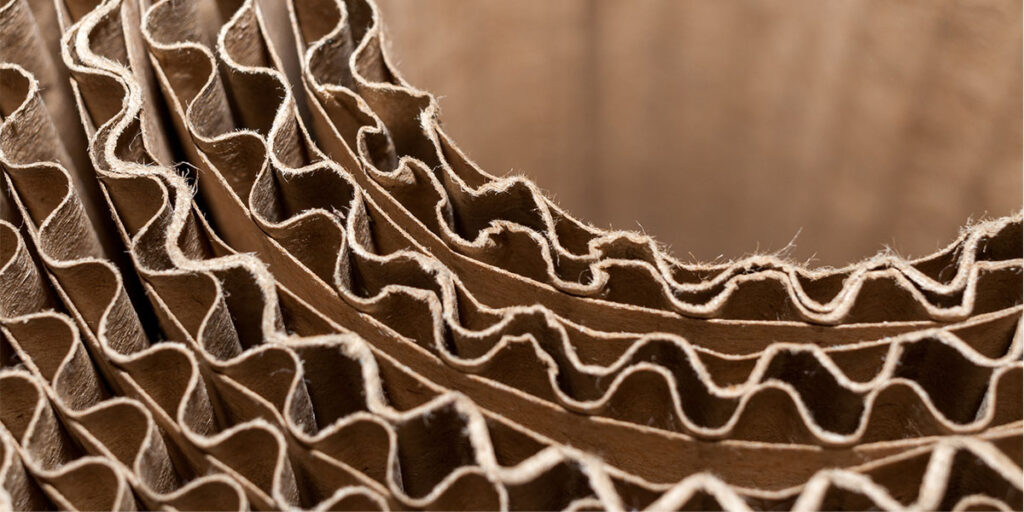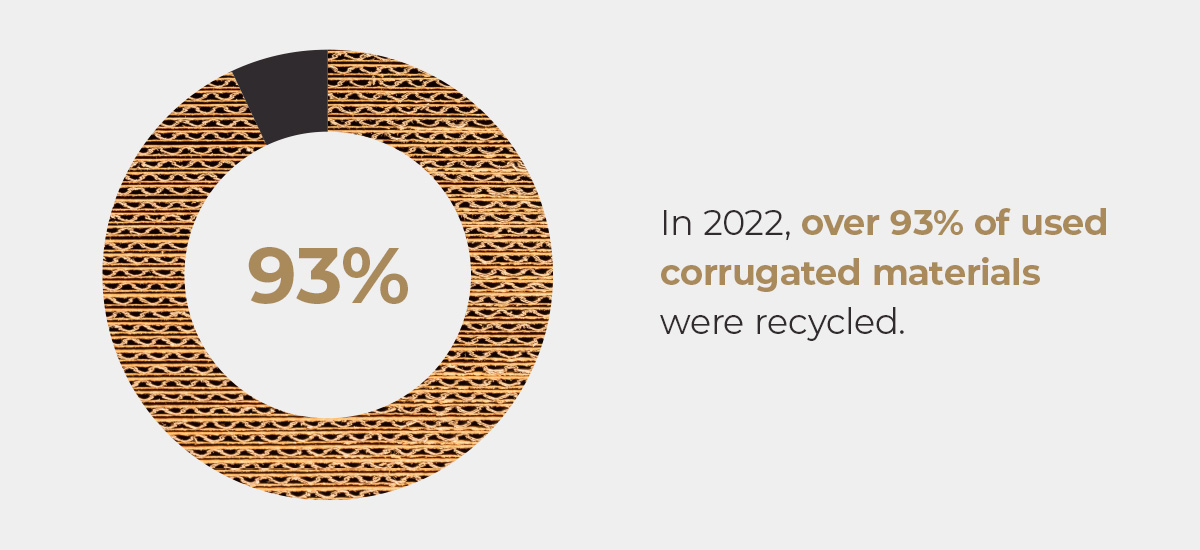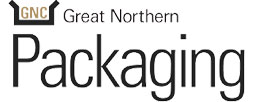
Corrugated packaging is a traditional material used to protect and transport products. We can attribute its widespread adoption and growing popularity to its environmental friendliness and ability to reduce carbon footprints. Using sustainable corrugated cardboard packaging can attract environmentally conscious consumers and improve your brand’s reputation.
Explore the key factors making corrugated packaging more sustainable below.
What Is Corrugated Packaging?
Manufacturers produce corrugated packaging by combining three or more sheets of liner board to create a sturdy, durable material. Corrugated paperboard has a fluted design that enhances the material’s strength with air columns, making it sturdier than average cardboard while creating cushioning for the products placed inside.
You can customize corrugated packaging boxes to fit products snugly and reduce material waste.
The structure of corrugated packaging renders it numerous uses in various industries, which include:
- E-commerce: E-commerce businesses utilize corrugated material as secondary packaging to assist with product handling, storage and distribution.
- Food and beverage: Corrugated packaging is a clean material that prevents contamination with harmful bacteria and the growth of mold and decay. It can also ensure a longer shelf-life, keeping food and beverage products safe until they reach consumers.
- Retail: Businesses can use the material to store and display products on retail shelves. They can customize point-of-sale corrugated packaging to create counter and free-standing displays in stores.
- Heavy-duty shipping boxes: The strong and durable material is ideal for reliably handling heavy and irregular products. Businesses can choose double- or triple-walled corrugated boxes to achieve greater protection.
Benefits of Using Corrugated Packaging
Corrugated paperboard has many benefits that make it a popular packaging material. Here are some of the top benefits:
- Lightweight: It’s made of lightweight paper composites, which creates lighter packaging that saves labor, transport, handling, fuel and energy costs.
- Cost-effective: The material is more affordable than alternative packaging materials like plastic, glass and metal. Its friendly price point is due to the cost-effectiveness of manufacturing corrugated cardboard boxes and their recyclability.
- Strength: Corrugated packaging fibers are sturdy and resist tears and damage. The material has a high strength-to-weight ratio, providing ample cushioning and protection without adding excess weight.
- Customizable: Corrugated packaging is a flexible material that can be crafted into various designs, sizes and shapes to accommodate odd and irregularly shaped products.
- Protective: Corrugated packaging reliably protects goods against vibrations, shocks, mechanical damage, moisture and dust. Businesses can also enhance these boxes to minimize potential environmental impacts.
Environmental Impact of Corrugated Packaging

Corrugated packaging is made from natural, renewable sources, such as trees, woodchips and leftover materials, ensuring the industry is self-sustaining. Another viable option is using recycled materials that require less energy to produce than 100% virgin options.
Using locally sourced, recycled materials can reduce the environmental impact of corrugated packaging by minimizing transportation costs and fuel consumption. Transporting the finished boxes is affordable and minimizes carbon footprints.
Businesses can customize corrugated boxes to reduce waste, and this packaging is stackable to use less storage space. It also decreases the amount of material required by making it collapsible, reusable, and recyclable for multiple purposes. In 2022, over 93% of used corrugated materials were recycled.
Corrugated packaging boxes are also biodegradable, meaning they will decompose significantly faster than plastic by the end of their life cycle. Instead of sending this packaging to the landfill at the end of its useful life, you can add it to a compost pile, which breaks down into organic matter that improves soil and plant quality. Composting reduces waste disposal costs and greenhouse gas emissions associated with disposal.
Sustainability Initiatives for Corrugated Packaging
The corrugated carbon footprint is low because of numerous sustainability initiatives employed throughout the material’s life cycle. Among these initiatives is using recycled materials like boxes and newspapers, which you can reuse and recycle multiple times. When using paper pulp, manufacturers derive the material from sustainably grown forests where the trees, like birch and pine, are easy to replace and grow.
The production process avoids using chemical treatments like harsh dyes and bleach that may harm the environment. Manufacturing facilities use innovative high-speed equipment to increase production capacity while minimizing energy consumption and packaging waste. Producing custom-sized boxes helps to decrease a business’s carbon emissions from shipping and transport.
Corrugated packaging manufacturing facilities must meet strict state, local and Environmental Protection Agency (EPA) environmental rules and regulations to reduce the impact of the processes on air, soil and water. They must follow the Emergency Planning and Community Right-to-Know Act to protect local communities from exposure to hazardous chemicals. They must also acquire a Forest Management Certification from the Forest Stewardship Council to ensure biological diversity preservation.
Sustainability Comparisons With Other Packaging Options
Corrugated packaging is more sustainable than other popular packaging options, and here’s how it compares:
- Plastic packaging: Plastic packaging is a durable option but truly unsustainable because only 9% of plastic waste is recycled. Switching to more sustainable corrugated packaging reduces the dangerous amount of plastic ending up in landfills, oceans, lakes and rivers.
- Glass packaging: Glass is a relatively sustainable packaging material with about a 31% recycling rate, which makes corrugated packaging the better option. It also takes much longer for disposed glass to decompose.
- Metal packaging: Metal is a strong material that accommodates various packaging needs, but it is heavy and expensive for businesses to transport.
Consumer Awareness and Choices
Consumers are driving the growing need for sustainable choices, and they are concerned about the environmental impact of the products they buy. As a result, 60% of American consumers say they are willing to pay more for products with environmentally friendly packaging.
Another survey predicts the corrugated packaging boxes market will have a compound annual growth rate of 4.4% between 2024 and 2033. The expected growth is driven by the demand for the material in various industries, including food and beverage, e-commerce, electronics, pharmaceuticals, health and beauty.
Future Trends in Corrugated Packaging
Experts anticipate the corrugated packaging market will grow significantly, thanks to numerous trends, such as:
- Increasing integration of technology in the production of corrugated packaging to increase capacity and reduce energy use and waste.
- The growing number of brand owners choosing corrugated packaging to protect and align the goods with their brand’s identity.
- The demand for secondary packaging solutions to create a sterile barrier for consumers.
Get Sustainable Corrugated Packaging From Great Northern Packaging
Great Northern Packaging is a reliable manufacturer of sustainable corrugated packaging solutions made from renewable resources. In addition to innovative manufacturing technology that saves energy, we partner with an internal logistic partner that complements our efforts with efficient routing and better cube utilization.
Contact us today to learn more about our approach to sustainability. You can also explore our selection of sustainable custom commercial products and consumer packaging solutions to find the right one for your business.







